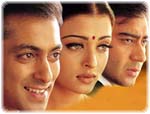
|
HUM DIL DE CHUKE SANAM("I've already given my heart, Dear") |
1999. Directed by Sanjay Leela Bhansali, 188 mins. Hindi. Music by Ismail Darbar, lyrics by Mehboob.
Given that the plot of this big-budget film is heavily indebted to HUM AAPKE HAIN KOUN! and DILWALE DULHANIYA LE JAYENGE (with a few twists thrown in) and that the two principal characters are pretty, pouty, and shallow, the real "stars" are the surreal locations and sets, which (through Anil Mehta's cinematography) revel in yantric geometries, suggesting, say, M. C. Escher on bhang. The action moves from an imaginary Guja-Rajasthan, where the heroine lives with her unaccountably-rich musician clan amid towering sand dunes and sparkling lakes, to an imaginary Italy, which is in fact (the apparently cheaper and more convenient) Budapest and environs. The latter locale provides a fine example of the purely generic nature of the Western topos, as the filmmakers are unconcerned by the fact that the broadly-gesticulating locals are shouting at one another in Hungarian and speaking English with thick Magyar accents. Who cares, when videshis are merely faceless extras and what really counts are soaring church spires, bright-colored trams, and illuminated suspension bridges?
Doe-eyed, slim-waisted Nandini (the stunning Aishwarya Rai) lives in a house that pushes the palatial standard of HAHK up several notches—a sort-of hilltop version of the Lake Palace Hotel, used to great advantage in musical numbers that largely celebrate (Hindu) celebrations: Diwali, Holi, the women's fast-day of Karwa Chauth, and the start of kite-flying season (which shows what Busby Berkeley might have done had he known Indian kites). The family patriarch lives for his vocal art and his pampered daughters, who flit through a kaleidescope of shimmering fabrics, flickering oil lamps, and mirrorwork. Into this idyllic ethnoscape blows the proverbial NRI inside-outsider: here, a Hindi-speaking Italo-Indian hunk named Sameer ("breeze," Salman Khan) with poor cultural skills and a penchant for removing his shirt—leaving him with merely an array of tight jeans in every hue. He also sings "from the heart," charming the patriarch, and, in time, wooing his daughter through his trademark Hyperactive Attentiveness. Despite all this, Sameer is "not Indian!" and so Maam and Baap eventually banish the Breeze and pair up Nandini's horoscope with that of a nice, rich lawyer named Vanraj (Ajay Devgan), who is "unattractive" (i.e., slightly dark), flabby, and tone-deaf. He has a big heart, though, and big, suffering eyes, which are fully deployed once he realizes that his chilly bride has "already given her heart" to another, and selflessly whisks her off to Buda-ly in search of the elusive Sameer.
Cameos by two venerable actresses (Zohra Sehgal as Nandini's grandmother, and Helen as Sameer's mom) spice up the two halves of the film. Although just how Sameer and his Hindi-speaking mother ended up in the West is never explained, his absent father—who communicates with him through peals of thunder and church altarpieces—seems to have been the Holy Spirit. This alone might appear to qualify Sameer to win the Princess Bride, but then Christianity (like Euro-ethnicity) is here merely another chip in a glitzy, global mirrorwork which is ultimately held together by the irreproachable suhaag maalaa (marriage necklace) of the auspicious Hindu woman. As with other big-budget films in its immediate family (HAHK, DDLJ, PARDES, KUCH KUCH HOTA HAI, etc.), HUM DIL's opulent but hegemonically-Hindu world looks more than a little ominous in the contemporary socio-political context.